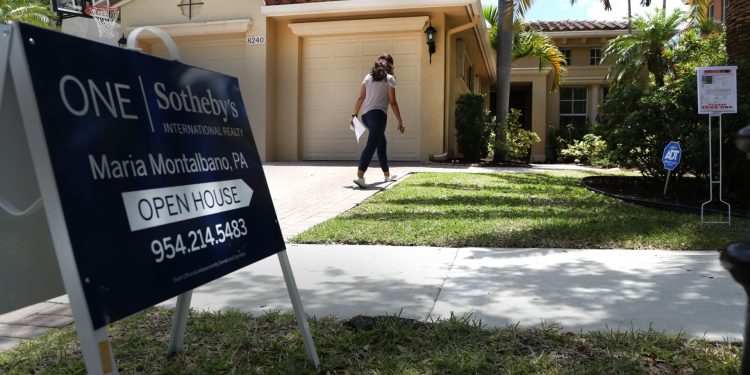Prospective buyers take a tour during an open house at a home in Los Angeles, California, United States, Sunday, July 13, 2025.
Eric Thayer | Bloomberg | Getty Images
Overall, demand for mortgages weakened further last week, even as interest rates fell slightly. However, those still in the market are increasingly turning to variable rate loans to get the lowest interest rate possible.
Total mortgage application volume fell 4.7% last week from the previous week, according to the Mortgage Bankers Association’s seasonally adjusted index.
The average contract interest rate for 30-year fixed-rate mortgages with conforming loan balances of $806,500 or less decreased to 6.43% from 6.46%, with points falling from 0.61 to 0.60, including origination fees, for loans with a 20% down payment. The rate was only 7 basis points lower the same week a year ago.
Requests for refinancing a home loan, which had increased sharply in mid-September then declined two weeks ago, fell again last week, down 8%. Refinancing demand is still 18% higher than it was the same week a year ago.
“With mortgage rates on fixed-rate loans changing little last week, refinance application activity generally declined, with the exception of a slight increase for FHA refinance applications,” said Mike Fratantoni, MBA senior vice president and chief economist.
Mortgage applications to buy a home fell 1% over the week and rose 14% year over year. Buying demand hasn’t changed much in recent months as potential buyers face high prices and growing uncertainty in the economy. While the supply of homes for sale is higher than it was a year ago, more sellers are delisting their properties or choosing to wait before listing them.
For those purchasing or refinancing, slightly riskier adjustable-rate mortgages are gaining popularity because they offer lower interest rates. ARM rate terms can be fixed for up to 10 years, but the loans are considered riskier because they can adjust higher based on market conditions when the fixed term expires.
“The ARM share increased to 9.5 percent last week, up from 8.4 percent the week before. Our survey shows that 5/1 ARM rates are on average nearly a percentage point below 30-year fixed rates, and this gap is leading more homebuyers and refinancers to consider ARMs,” Fratantoni said.
Mortgage rates didn’t do much early this week as the lack of government data on the economy due to the shutdown kept bond markets relatively calm.









